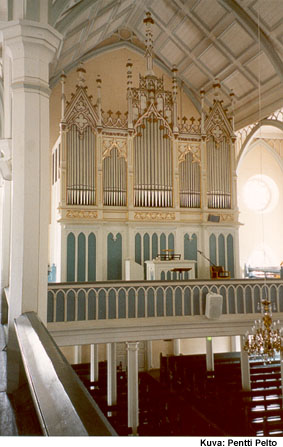|
HISTORICAL ORGANS IN FINLAND 
Asikkala Church- Jurva, Juho Albanus 1903
- 32 stops, 2 manuals and pedal
- pneumatic action and pneumatic stop action
Asikkala Church is a Neo-Gothic brick church that was completed in 1880 to plans by Georg Wilenius. It is a nave church with steeple, with short transepts and a segmented choir. Pillars sub-divide the interior into three aisles.
Albanus Jurwa built a large organ in the church in 1903. It was repaired and expanded in 1966; in 2000, Sotkamon Urkurakentajat Oy restored the sound of the instrument to its original state. The Asikkala organ is valuable not only because of its size but because of its sound and appearance.
Appearance
The organ is located in the western loft of a large church. It has a sizeable and impressive façade, and the organ case is spacious. The divisions are placed asymmetrically: the Manual II swell box is at the left edge of the case, behind it is the maintenance access space and then the Pedal division. The large Manual I division is at the right edge. Behind this is the small three-stop chest added in 1966. The console is in the front of the organ in the middle, and the organist sits facing the church.
The façade is divided into five sections. The middle and outermost flats are of equal height and are topped with pediments, whereas the intermediate flats are slightly lower and oblong. The Neo-Gothic top half of the façade is characterized by high finials with gilt flowers and other decorations. The lower half is painted blue and white. The upper parts of the side frames of the chest have a dense wire mesh instead of panels, probably to allow a louder sound. The mouths of the façade pipes form a horizontal line.
The façade design is simple and austere. Its large proportions make it impressive.
Technical features
The chests are pneumatic stop channel chests whose pallets are operated by pallet bellows of various sizes. Each stop channel is covered on its lower surface with a glass panel, making it easy to locate any faults. The action was originally pneumatic but was converted to electric in the repairs carried out in 2000. The electric action is transferred to pneumatic in converter units placed near the chests.
The original large and richly decorated console was reinstated in the most recent repairs. The mechanical coupling machinery removed from within it is displayed as a museum item in the loft, together with the three-keyboard console built in the 1966 repairs. The keyboards of the current console have celluloid and ebony coverings. The bipolar stop switches seem to constitute a third keyboard: the lower part of a stop switch activates the stop, and the upper part deactivates it.
The organ has a single large bellows placed under the chests, with channels leading to each chest. The wind volume required is huge, since there are several 16' stops even in the manuals. It seems that the bellows and channels were slightly inadequate to begin with: fluctuations occur easily, and with large combinations the wind pressure seems to drop. This, however, is an original characteristic of the instrument and must be accepted as such.
Musical properties
The manual keyboard keys have large lead counterweights. This makes the touch heavy, even reminiscent of a mechanical action, and thus it has always been different from the usual touch of a pneumatic action. The new electric action has not changed the touch. The instrument is large, and hearing and assessing registrations from the organist's seat requires experience and practice. The sound is soft and singing, with a number of colourful individual stops.
There is a separate console for the electrical combination machinery. The original disposition of the organ is available on the console, but the three extra stops on the new chest behind the main division can only be accessed through the extra console. Two of these stops date back to the 1966 repairs; the third was added in 2000.
The German Romantic principle is obvious in the organ. Manual I is grand and powerful, while Manual II is quieter and more lyrical. A swell box makes it possible to render it even quieter. As a whole, the instrument has a wide dynamic range and a profusion of solo colours.
Present disposition
Manual I C-f3 | Manual II C-f3 | Pedal C-d1 |
Principal 16’ | Lieblich gedackt 16’ | Principal 16’ |
Bourdon 16’ | Geigenprincipal 8’ | Subbass 16’ |
Principal 8’ | Lieblich gedackt 8’ | Gedacktbass 16’ |
Bourdon 8’ | Salicional 8’ | Flötenbass 8’ |
Flauto major 8’ | Aeoline 8’ | Violon 8’ |
Concertflöte 8’ | Voix celeste 8’ | Violoncello 8’ |
Gemshorn 8’ | Viola 4’ | Oktave 4’ |
Gamba 8’ | Flauto dolce 4’ | Posaune 16’ |
Ouintatön 8’ | Oboe 8’ | |
Principal 4’ | | |
Oktave 4’ | | |
Rohrflöte 4’ | | |
Kvinta 2 2/3’ (1965) | | |
Oktave 2' | | |
Waldflöte 2' (1965) | | |
Terz 1 3/5' (2000) | | |
Mixtur 3x | | |
Trompete 8' | | |
|
|
|
| | |
II-I, I-P, II-P, I-4’ | | |
Piano, mezzoforte, forte, tutti | | |
Manual II in swell box | | |
| | |
| | |
| | |
| | |
| | |
| | |
| | |
| | |
| | |
|